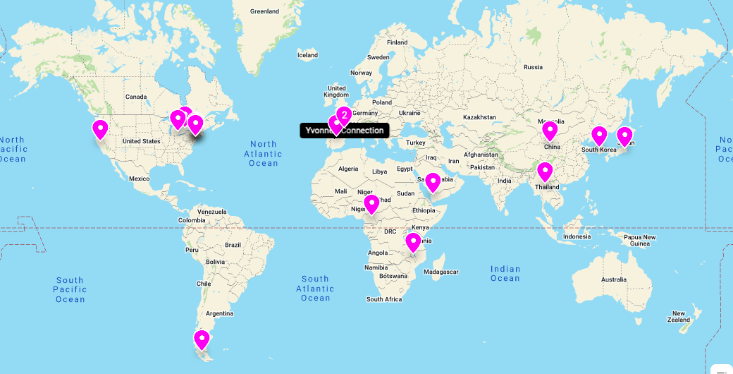For our lab presentation, we were thinking about how a particular place can often be the locus for a specific story, or group of stories, and how the particular place can be intimately connected to the stories being told. We had been thinking and talking about centering the space first and letting that space generate stories instead of thinking about narratives first and then seeing if they have a connection to any one place. We wanted to elevate the place so it had a co-starring role with the narrative itself.
During our lab presentation we shared a world map and asked participants to locate a place that was connected to a particular story or memory for them. Interestingly, though we didn’t collaborate, our own submissions shared some commonalities. Tay shared a photo of her living room in Toronto and wrote about its importance in her life as the source of so many important memories and how she felt a connection to the people who lived there both before and after. Peter shared a story he wrote about the previous inhabitant of his apartment remembering the many accomplishments of her life. We were pleased to see the variety of stories that participants shared as they spanned both the globe and narratives, especially as we initially planned for the activity to be centralized within the context of New York City. While the prepared reading for the session, an excerpt from E.B. White’s piece entitled Here is New York, certainly set the stage for this to be the case, we believe that the inclusion of a worldwide map allowed for participants to widen their consideration and memory of place-based narratives.

During our lab presentation we shared a world map and asked participants to locate a place that was connected to a particular story or memory for them. Interestingly, though we didn’t collaborate, our own submissions shared some commonalities. Tay shared a photo of her living room in Toronto and wrote about its importance in her life as the source of so many important memories and how she felt a connection to the people who lived there both before and after. Peter shared a story he wrote about the previous inhabitant of his apartment remembering the many accomplishments of her life. We were pleased to see the variety of stories that participants shared as they spanned both the globe and narratives, especially as we initially planned for the activity to be centralized within the context of New York City. While the prepared reading for the session, an excerpt from E.B. White’s piece entitled Here is New York, certainly set the stage for this to be the case, we believe that the inclusion of a worldwide map allowed for participants to widen their consideration and memory of place-based narratives.

The ensuing discussions in small groups brought up additional ideas and questions, especially around the choice and use of particular map styles as well as ideas about centering stories of place in the context of colonization and decolonial practices. In the future, were we to facilitate this activity again, we would design several guiding questions that explore this aspect of place-based narrative, particularly as it is situated in countries and continents external to the U.S. and North America.
We also discussed the concept of who decides what is “important” when it comes to mapping and geography. An interesting idea that arose from these conversations was the distinction between what is most visible and notable on Google Maps versus what places participants consider to be most important based on their own personal experience and memory. These two distinctions were often in conflict, and would also be a fascinating area of exploration if this activity were to be replicated.
From this experience, Peter took away an interest in getting students to think about the important places and spaces in their lives and what stories these spaces generate for them. And, thinking about ways that a particular place they know is impacted by various social justice issues and ask themselves if their place is connected to some form of oppression or neglect that they want to identify and work to improve.
From Tay’s perspective, she would be interested in the areas of exploration discussed above, as well as running the activity with students from various age groups and backgrounds to observe the variation in small-group discussion topics. She would also recommend this activity as a strong class “icebreaker” for middle- to high-school students, as the aspects of identity that arise in the submissions and resulting discussion have the power to evoke narratives and information that may not otherwise be thought of or shared.
To learn more about the activity and/or request materials from this particular session, please feel free to contact Tay at tal2153@tc.columbia.edu or Peter at pb2860@tc.columbia.edu.